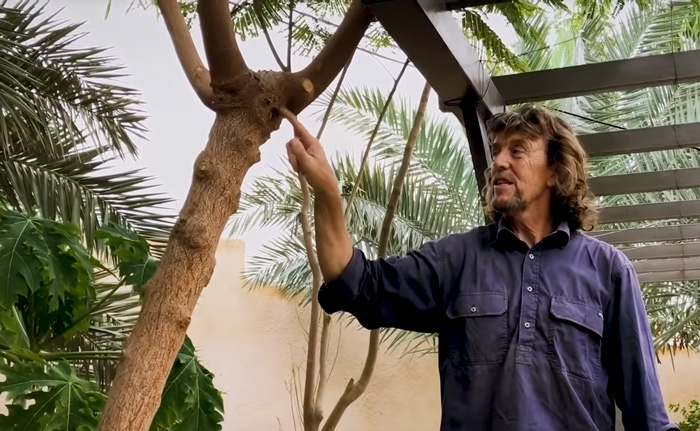Margie writes:
“You always say that we can plant a food forest ‘anywhere’ but I still have trouble with almost any ‘food trees’ except for mulberries. I live in Tucson, AZ and the ‘soil’ on my property is mostly caliche which is another word for concrete. We have to use a pickax to dig holes for trees and even the “easiest to grow fruit trees” rarely make it here except those amazing mulberries. Would mulch over cardboard or just plain mulch (I have two huge piles of wood chips from a chip drop (mostly mesquite and palo verde chips) work by themselves or would cardboard make it better to help keep the weeds to a minimum? The pile of chips has grown some big fat grubs, which the roadrunners love. Would I also get worms?”
When I say you can plant a food forest “anywhere,” I don’t mean it quite universally. If you live on the Antarctic Ice Shelf, you’re probably out of luck. But Tucson? Sure, you can grow a food forest.
A clue to success is already in her email.
“…and even the “easiest to grow fruit trees” rarely make it here except those amazing mulberries.”
Ah-ha, there is a successful tree already there.
Though it’s not an easy climate due to the low rainfall (Tucson gets about 11″ of rain a year), it’s not impossible. Some trees grow there, which means the key is figuring out how to find the best for her land, and to improve the land so it can grow a wider variety.
In the first few years of my North Florida food forest, we struggled to keep our trees happy. After we got a thick layer of mulch down that started composting, and got more plants living in the soil, new trees and plants did better as soon as they were planted – much better than the first ones we put in. The soil was alive.
Plant lots of trees and see what lives, concentrating particularly on scrappy biomass producers and nitrogen-fixers to begin with. And that mulch is great, too. If you remove all the weeds first, you don’t need cardboard. But if you have tenacious weeds, I would put down cardboard first, then mulch over it.
As for desert food forests and biomass, Geoff Lawton shares some inspiration here:
I would also look around your area for other gardeners and connect with them. YouTubers, as well:
Here’s a Tucson gardener:
And another:
And here’s one in Glendale:
If you put down those wood chips, yes, you should get some worms of various types if they are anywhere near you. You could add them as well, via visiting a bait shop.
Good luck!
If you want to interact with other gardeners and see the new food forest course, come join our new Survival Gardener Community. There are multiple desert gardeners there already.


4 comments
A differing opinion on the value of cardboard as mulch: I question the value of intact cardboard as a first-layer mulch near fruit trees in arid climates, or even in dry periods in non-arid climates. Intact cardboard can divert water flow away from tree roots (very undesirable in arid climates or dry period in other climates), and it can take some time for the cardboard to decay sufficiently such that there is no more water diversion. However, if one wants to smother weeds in locations away from trees and shrubs, then intact cardboard is OK.
Yes, that makes a lot of sense.
I would check out Brad Lancaster. I believe he lives (or lived) in Tucson and has some great advice on harvesting the rainwater. Between David’s examples on how to simplify gardening and Brad’s on how to keep rainwater in the soil, I’m having much better luck dealing with sand, caliche, alkalinity, and extreme temperature.
Very good advice. I have heard great things about him.
Comments are closed.